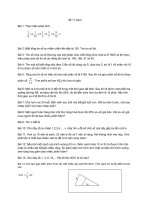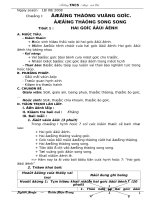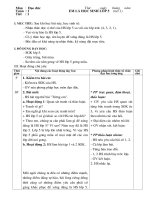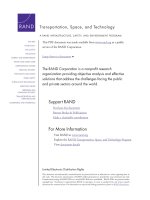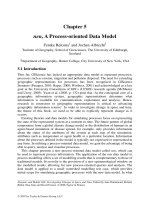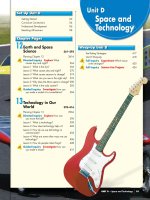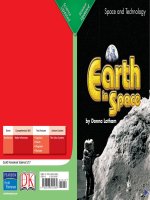- Trang chủ >>
- Mầm non - Tiểu học >>
- Lớp 5
5 5 2 inventions from space travel (space and technology)
Bạn đang xem bản rút gọn của tài liệu. Xem và tải ngay bản đầy đủ của tài liệu tại đây (4.48 MB, 14 trang )
Suggested levels for Guided Reading, DRA,™
Lexile,® and Reading Recovery™ are provided
in the Pearson Scott Foresman Leveling Guide.
Space and Technology
Inventions from
Space Travel
Genre
Expository
nonfiction
Comprehension
Skills and Strategy
• Graphic Sources
• Generalize
• Ask Questions
Text Features
• Captions
• Heads
• Glossary
Scott Foresman Reading Street 5.5.2
ISBN 0-328-13567-4
ì<(sk$m)=bdfgh < +^-Ä-U-Ä-U
by Peggy Bresnick Kendler
and Phyllis A. Corzine
Vocabulary
absorb
friction
impacts
insulation
perilous
Reader Response
1. Explain what the map on page 6 shows. Explain how
NASA technology affects our daily lives.
2. Use a chart like the one below to write down
questions you could ask as you reread the section
about space inventions used in sports.
Inventions from
Space Travel
Invention
Question
relics
shuttle
transmitter
Word count: 2,639
Note: The total word count includes words in the running text and headings only.
Numerals and words in chapter titles, captions, labels, diagrams, charts, graphs,
sidebars, and extra features are not included.
3. Choose five words from the glossary and write a
paragraph that shows that you know each word’s
meaning.
Peggy
4. Of by
all the
inventionsBresnick
and technologyKendler
discussed in this
andone
Phyllis
A. isCorzine
book, which
do you think
the most important?
Explain your answer.
Editorial Offices: Glenview, Illinois • Parsippany, New Jersey • New York, New York
Sales Offices: Needham, Massachusetts • Duluth, Georgia • Glenview, Illinois
Coppell, Texas • Ontario, California • Mesa, Arizona
From the Stars to the Kitchen
Can you imagine using a portable phone or a
smoke detector on the moon? It sounds crazy, but
we use many products that were made for the space
program. We use these products everywhere from
our homes to hospitals, firehouses, and airports.
Scientists from the National Aeronautics and
Space Administration (NASA) develop products
to help astronauts while they are in space. These
products help astronauts live in space, do their jobs
better, and protect themselves from danger. Many
of these products have made their way into general
use. How did that happen? Read on.
Every effort has been made to secure permission and provide appropriate credit for
photographic material. The publisher deeply regrets any omission and pledges to
correct errors called to its attention in subsequent editions.
Unless otherwise acknowledged, all photographs are the property of Scott Foresman,
a division of Pearson Education.
Photo locators denoted as follows: Top (T), Center (C), Bottom (B), Left (L), Right (R),
Background (Bkgd)
Cover ©James L. Amos/CORBIS; 1 ©Bettmann/CORBIS; 3 (Bkgd) ©Digital Art/CORBIS;
3 (TL) ©Tom Wagner/CORBIS SABA; 3 (TR) ©RICK FRIEDMAN/Corbis; 4 ©Bettmann/
CORBIS; 6 ©Bettmann/CORBIS; 7 ©Bettmann/CORBIS; 8 ©Gunter Marx Photography/
CORBIS; 9 ©Randy Faris/CORBIS; 10 ©James L. Amos/CORBIS; 12 ©Richard T. Nowitz/
CORBIS; 15 ©Lester Lefkowitz/CORBIS; 17 ©MENAHEM KAHANA/AFP/Getty Images;
19 ©NASA/Corbis; 20 (TL) ©RICK FRIEDMAN/Corbis; 20 (TR) ©Tom Wagner/CORBIS
SABA
ISBN: 0-328-13567-4
Copyright © Pearson Education, Inc.
All Rights Reserved. Printed in China. This publication is protected by Copyright,
and permission should be obtained from the publisher prior to any prohibited
reproduction, storage in a retrieval system, or transmission in any form by any
means, electronic, mechanical, photocopying, recording, or likewise. For information
regarding permission(s), write to: Permissions Department, Scott Foresman, 1900 East
Lake Avenue, Glenview, Illinois 60025.
4 5 6 7 8 9 10 V0H3 14 13 12 11 10 09 08 07 06
These inventions were developed from products first
used by astronauts in space or used by the U.S. Space
Program in some way.
3
Space Products at Home
and in the Skies
Take a good look around your home. Can you tell
which things came from products first used in space?
You might be surprised at the things that were
invented for astronauts.
Astronauts on lunar missions have had to drill as
many as ten feet down into the moon’s crust to get
samples of dirt and rock. Since there is no source of
electricity on the Moon, a battery-powered cordless
drill was created for this job. The drill had to be
powerful and lightweight.
In the years following the moon missions, cordless
power tools have become common in homes
throughout the world. Today we clean our carpets
with cordless vacuum cleaners, blow leaves and grass
cuttings using cordless blowers, and install screws
or drill holes in wood using cordless screwdrivers
and drills. Many families use cordless toothbrushes,
shavers, and hair clippers.
In the 1970s, NASA teamed up with an electronics
company, and together, they developed a smokeand-fire detector for the Skylab space station. With
this invention, astronauts on the space station could
be alerted quickly to dangerous smoke and fire. Now
it is a law in most states to have smoke detectors in
every new home to help keep people safe.
Fire and smoke detectors also are used in
airplanes. NASA scientists found that smoke detectors
sometimes gave false alarms in the space station
and in airplanes. Fire and smoke detectors that were
being used in airplanes were sometimes triggered
by dust in the cargo compartments. False alarms
caused airplane pilots to take unnecessary emergency
measures, so scientists are at work to develop a
smoke detector that will avoid false alarms.
Smoke and fire detectors make people safe at home
and while they travel.
The portable drill for use
in space led to the portable
drill used on Earth.
4
5
ANDOVER
VIA
TELSTAR
WASHINGTON, D.C.
ENGLAND
Television signals were sent by Telstar I between Europe and
the base station in Andover, Maine.
Do you enjoy watching sports programs such as
the Olympics? Do you watch the news to see what is
happening around the world? You can watch a live
sporting event from another country or watch news
from a foreign land live as it unfolds thanks to space
technology. Fifty years ago, it was impossible to
watch live overseas television broadcasts.
In the 1950s, NASA began working with American
Telephone and Telegraph to make satellite television
a reality. On July 10, 1962, NASA launched a tiny
satellite called Telstar I from Cape Canaveral in
Florida. Once Telstar was in orbit high above Earth, it
was able to receive and send television signals to its
base station on Earth.
6
Telstar I orbited Earth
every 2 hours and
37 minutes.
Telstar’s first television broadcast was of a flag
outside its base station in Andover, Maine. On July
23, 1962, Telstar relayed the first live transatlantic
television programming. The programming was
received in Europe and included American President
John F. Kennedy giving a press conference. By
1964, more telecommunication satellites had been
launched into orbit, and they were able to transmit
the Olympic Games in Tokyo, Japan, to televisions
all over the world. This was the first major sporting
event shown live, worldwide.
Now people in many nations enjoy satellite
television that delivers hundreds of channels from
around the world to their homes. All over the United
States, you can see small satellite dishes on the roofs of
houses. News vans and trucks carry satellite uplinks that
transmit audio and video to their base stations and
throughout the world. Thanks to space technology,
we can find out what is happening in far parts of our
planet—almost as soon as the events take place.
7
Space and Sports
Space technology has also brought innovation
to the world of sports. New materials help athletes
perform better, stay safer, and recover from injuries
more quickly.
For example, NASA created a safety material used
in bicycle helmets. The material, called temper foam,
was developed for use in the seats of aircraft to absorb
sudden impacts without shock or bounce. Helmets
fitted with temper foam have saved many lives.
Believe it or not, astronauts’ spacesuits have
something in common with the roofs of some sports
stadiums. They are both made of the same space-age
material. This fabric contains a fiber made of glass
and covered with Teflon, a strong, slick coating. This
type of roofing material is strong but lightweight,
and it allows natural light to filter into the stadium
during daylight hours. The roof of a stadium in
Vancouver, British Columbia, is covered with ten
acres of this moon-suit material!
Spacesuits were developed to protect astronauts
from the extreme temperatures they would
encounter during space walks and during their
explorations on the moon. The technology employed
to design astronauts’ spacesuits also helped scientists
develop products to treat athletes’ injuries. When
athletes are injured, one common treatment is to
wrap the injury with tight bandages and apply cold
packs to it. However, using too much ice for too long
can make the injury worse.
Using the same type of temperature and pressure
control devices used in space suits, scientists have
developed special wraps that fit around body parts,
such as the knee, back, shoulder, and wrist. These
wraps use batteries to compress, or squeeze, the
injured part of the body. The wraps also apply cold
at just the right temperature for the right length of
time. Professional athletic trainers report that these
wraps help athletes recover in half the time.
NASA science helps keep people warm and dry at stadiums.
8
9
The same space technology used to treat injuries
was used to develop a vest that cools down the entire
body. Athletes who play during extreme summer heat
sometimes suffer from heat exhaustion or heat stroke.
The vest, which includes a hood, looks like an ordinary
piece of clothing. However, when it is attached to a
cooling unit, the vest quickly and safely lowers the
body temperature of its overheated wearer.
The fusion of space technology with sports
technology involves more than safety, however.
Space technology is helping athletes improve their
performance as well. In Olympic swim competition,
for example, a fraction of a second can mean the
difference between first and second place. NASA
scientists have developed riblets—small, barely
visible grooves on aircraft wings that decrease
friction. When applied to fabric used in competition
swimsuits, these riblets reduced friction, allowing
swimmers to move more swiftly through the water—
ten to fifteen percent more swiftly.
10
Not only swim suits but also swimming pools have
been improved by space technology. Astronauts
needed a way to filter and purify their water in
space. NASA scientists developed a method of
destroying and filtering out bacteria without using
chemicals. That technology is now used in swimming
pools as well as in space. The new system reduces the
need for chlorine in pools. Swimmers no longer need
to suffer from burning eyes and bleached or dry skin
and hair caused by chlorine.
11
The Firehouse and
Space Technology
Space Technology—
Keeping People Safe
Astronauts and firefighters have a lot in common.
Both need to protect themselves from perilous
conditions. Both need to count on technology to
help them breathe when the air is not safe or when
there is no air to breathe at all.
A better breathing system for firefighters is the
result of important technology developed by NASA.
This breathing system for firefighters is based on
the systems astronauts use on the moon. It has a
facemask, a frame and harness, a warning device,
and an air bottle. The system weighs less than twenty
pounds, which is much lighter than the older systems
firefighters used. The lighter the unit, the easier it is
for a firefighter to move quickly and to best advantage
to help fight a fire. This system is also able to warn
firefighters when their air supply is getting low.
The space shuttle has two rocket boosters that
separate from the rest of the shuttle using small
explosive charges. Firefighters and rescue workers
also use rescue tools that are powered this way to
cut through metal at a crash or disaster site. This
way, they can help free people who are trapped in
a car or other vehicle. These tools take only thirty
seconds to set up, and they are lightweight.
Imagine what might happen if an elderly
person were injured at home and could not reach
a telephone. Space technology can help in such
an emergency. Using a communication system
created for use in space, scientists developed a small
transmitter about the size of a writing pen. This
device sends a silent signal to a receiver that shows
the exact location of the emergency. The transmitter
is small enough to carry easily. The device can be
used not only by elderly people, but also by teachers,
prison guards, and disabled people.
Thunderstorms can be dangerous to people
out in the open. Space technology is the basis for
a personal storm warning system. This lightning
detector gives a thirty-minute warning to people
who may be in danger. People on golf courses,
people in boats, and pilots of small private airplanes
who use this warning system can take steps to reach
safety before lightning becomes a danger.
Astronauts need a suit that will protect them
in space. Firefighters now use similar suits to
protect them from fire.
12
13
All aircraft
electronic systems
are protected from
lightning thanks to
NASA researchers.
Flying High with Space Products
in the Air
Millions of people travel on airplanes every
year. The safety of passengers is very important to
travelers and airport personnel.
Wind shear, or the sudden change in wind speed
or direction, is dangerous to a plane, especially
during takeoff and landing. The Federal Aviation
Administration (FAA) and NASA worked together
to find a way to predict wind shear. They wanted to
provide airplane pilots with a warning system that
would help them protect their aircrafts.
The solution they developed was a system that
uses microwave radar technology. The plane beams
a radio wave ahead of itself that detects rain and
winds. A computer uses the data that bounces back
to the plane to detect wind shear. If such conditions
exist, the pilot can fly around the problem area,
rather than through it.
14
Meteorologists also use radar technology to
predict storms. Weather radar helps the weather
service determine where and when to issue severe
weather warnings.
With so many people flying for business and
pleasure, it is no surprise that our skies are crowded
with airplanes, especially near airports. The FAA
helped develop the Traffic Alert Collision Avoidance
System. This system warns pilots when they come too
close to another plane. NASA helped test the system,
and today all airlines use it.
Reducing fuel use and preventing environmental
pollution is also a concern for airlines. A number of
technological developments made by NASA help
aircraft engines reduce the amount of fuel they use
by as much as ten percent. This technology also helps
engines run quieter and burn cleaner, reducing noise
and air pollution.
15
Space Technology and Medicine
Technology initially developed by NASA scientists
has also helped medical doctors with their work.
For example, the space shuttle’s outer fuel tank
is covered with a foam padding, or insulation. It
protects the tank from heat and is lightweight and
strong. Doctors have found another use for this
insulation. They use the foam material to make
molds to fit artificial arms and legs.
Thanks to NASA, we have thermometers that will
take a person’s temperature in just two seconds.
NASA used this same technology to measure the
temperatures of stars and planets far from Earth.
NASA also developed a tiny device to measure
astronaut’s blood pressure and temperature on the
International Space Station. This device is now being
studied for use in checking the health of unborn babies.
Many people today have decided they don’t want
to wear eyeglasses or contact lenses anymore. They
can now have laser surgery to correct their vision.
During this type of surgery, the laser beam must
be placed precisely on the patient’s eye. However,
the human eye makes small movements about one
hundred times a second. To keep the laser beam
trained directly on the eye, doctors use a tracking
device developed with NASA. This device measures
eye movements up to 4,000 times a second and
keeps the laser trained on the patient’s eye.
NASA technology has also developed a way of
detecting eye problems in very young children. This
screening device is able to make an accurate image
of a child’s eye so that vision problems can be found
and corrected early in life.
NASA developed digital image
processing to allow computerized
moon pictures. Today, this same
technology is used by doctors and
hospitals to show images of organs
in the human body.
16
17
Space Technology
Is a Work of Art
Many Dead Sea Scrolls such as this sample
are now readable thanks to
space technology.
Most of our country’s historical papers and relics
are kept in museums. People work to preserve them
because these items are old and can easily begin to
fall apart. Paper and ink are particularly vulnerable
to damage over time.
The Declaration of Independence, the Bill of
Rights, and the U. S. Constitution are stored in glass
cases in the National Archives in Washington, D.C.
Although these documents are protected and may
not be handled by the public, they could still be
damaged by light, humidity, or vibration. They are at
risk of deteriorating.
The National Archives asked NASA to create a
way to assess the condition of these documents. The
NASA laboratory worked with a company to create
an imaging device. Today, the National Archives has
a system that scans the papers at different times and
then compares the images. If there is a difference,
then change has likely occurred, and the National
Archives can act to stop the damage.
The Dead Sea Scrolls are religious texts written
more than 2,000 years ago. They have information
about the ancient Jewish religion and early
Christianity. The scrolls were found in the 1940s and
1950s in caves in the desert near the Dead Sea in
what is now Israel.
These ancient scrolls are in fragments and difficult
to read. The imaging device created with the help of
NASA was used to increase the contrast between the
ink and the parchment on which the text is written.
The device made portions of the scrolls readable.
18
19
Benefits from
Space Technology
Technology from NASA has given us ways to help
protect our environment too. These include methods
of protecting our oceans and preventing forest fires
from spreading.
NASA satellites can sense the location of forest
fires. This allows firefighters a better chance of
locating fires and keeping them under control.
The latest forest fire imaging system uses an
airplane with an infrared scanner that shows fire
boundaries. The sensor can see through heavy smoke
and debris to get a clear image of the fire area. All
data is processed on computers on the plane and is
sent to a computer at the firefighters’ camp.
This satellite photograph shows the location
of forest fires in California.
20
NASA technology also works to protect our
oceans. One way that scientists check the health of
our oceans is by measuring the amount of plankton
in the water. Plankton are very simple life forms, but
they are a major food source for ocean organisms.
Some types of plankton give off a natural glow
called bioluminescence. Bio means “life,” and
luminescence means “the generation of light.”
Using images taken by special equipment aboard
NASA satellites, scientists measure the amount of
bioluminescence. The amount of glow indicates the
health of the plankton, and as a result, the health of
the ocean.
Oil spills also damage Earth’s oceans. NASA helped
develop technology for cleaning up oil spills that
threaten ocean life. The solution was to use little
balls of beeswax containing bacteria and nutrients
for bacteria. The bacteria produces an enzyme that
degrades the oil.
At home, in the workplace, in the hospital, and in
nature, space technology is helping to improve our
lives, our health, and our environment.
21
Now Try This
More than 1,300 products have come from NASA
and the U.S. Space Program. More than 100 of these
technologies alone have been developed for our
space shuttle program.
It’s easy to imagine how some of the inventions
are used in space. Others are a little harder to figure
out. On the next page is a list of items we use in our
everyday lives. All these items were developed from
science used in our space program.
Your assignment is to be a space technology
detective.
to Do It!
w
o
H
s
’
e
r
He
Your mission is to read the descriptions of all items
on the list. Then, write a few sentences about how
you think each item is used in the space program. If
possible, compare your ideas with a classmate. When
you are finished, research each item to see whether
you were correct.
Space Pen: These pens were inspired by the Apollo
Space program. These pens have pressurized gas that
pushes the ink to the ball point, so they work if you
write upside down.
Flashlight: This space-age flashlight has a bright bulb
in its main system. It also has a separate battery and
bulb in a backup system.
Sun Tiger Glasses: These glasses have lenses that
block almost all the sun’s harmful radiation.
Thermal Gloves and Boots: These gloves and boots
have heating elements inside of them to warm cold
hands and feet. The heaters run on rechargeable
batteries.
Hand-Held Infrared Camera: Here on Earth, an
infrared camera can be held in your hand and can
scan for brush fires.
22
23
Glossary
Vocabulary
absorb
absorb
v. to take in or
suck up.
friction
friction
n. a force that
slows the movement of
things
that touch each
impacts
other.
insulation
impacts
n. the acts of
objects hitting other
objects.
perilous
insulation n. material
used
to hold in heat,
relics
electricity, sound, and so
on.
Reader Response
perilous adj. dangerous.
relics n. objects from the
past.
shuttle n. vehicle that
runs back and forth
between two points.
1. Explain what the map on page 6 shows. Explain how
NASA technology affects our daily lives.
2. Use a chart like the one below to write down
questions you could ask as you reread the section
about space inventions used in sports.
Invention
Question
transmitter n. a device
that sends out sounds or
signals.
shuttle
transmitter
Word count: 2,639
Note: The total word count includes words in the running text and headings only.
Numerals and words in chapter titles, captions, labels, diagrams, charts, graphs,
sidebars, and extra features are not included.
24
3. Choose five words from the glossary and write a
paragraph that shows that you know each word’s
meaning.
4. Of all the inventions and technology discussed in this
book, which one do you think is the most important?
Explain your answer.
